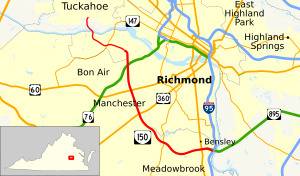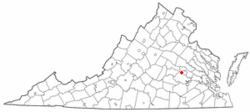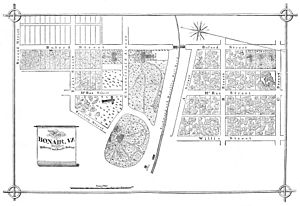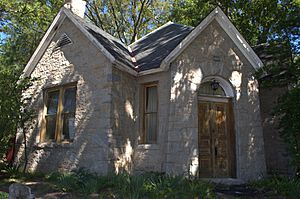Bon Air, Virginia facts for kids
Quick facts for kids
Bon Air, Virginia
|
|
|---|---|
|
Census-designated place (CDP)
|
|

Bon Air is located directly west of Downtown Richmond outside the city limits defined by the Chippenham Parkway on the south side of the James River.
|
|

Location of Bon Air, Virginia
|
|
| Country | United States |
| State | Virginia |
| County | Chesterfield |
| Area | |
| • Total | 8.3 sq mi (21.6 km2) |
| • Land | 8.3 sq mi (21.6 km2) |
| • Water | 0.04 sq mi (0.1 km2) |
| Elevation | 328 ft (100 m) |
| Population
(2020)
|
|
| • Total | 18,022 |
| • Density | 2,161/sq mi (834.4/km2) |
| Time zone | UTC−5 (Eastern (EST)) |
| • Summer (DST) | UTC−4 (EDT) |
| ZIP code |
23235
|
| Area code(s) | 804 |
| FIPS code | 51-08472 |
| GNIS feature ID | 1492605 |
Bon Air is a special kind of community called a census-designated place (CDP) in Chesterfield County, Virginia. In 2020, about 18,022 people lived there. Bon Air is like a suburb of the city of Richmond. It's part of the "Southside" area.
Long ago, Bon Air started as a resort town. People from Richmond would visit for its "good air." This was because the air in Richmond's industrial downtown was often dirty. Many old buildings from the late 1800s and early 1900s still stand in the central part of Bon Air. This area is now a special National Historic District.
Contents
What is Bon Air?
Bon Air is located entirely within Chesterfield County, Virginia. Most of it is in the 23235 ZIP code. It is bordered by Huguenot Road to the north, the city of Richmond to the east, Midlothian Turnpike to the south, and Robious Road to the southwest.
<mapframe text="Bon Air is bounded by Huguenot Road to the north and west, Powhite Pkwy and Chippenham Pkwy to the east, and Robious Road and Midlothian Turnpike to the South. " width=425 height=300 zoom=12 latitude=37.52 longitude=-77.53/>
Bon Air's Past
The area where Bon Air is today was first known as Brown's Summit. This name probably came from the Brown family farm nearby.
The Resort Era
|
Bon Air Historic District
|
|
| Nearest city | Richmond, Virginia |
|---|---|
| Area | 105 acres (42 ha) |
| Architectural style | Stick style, Queen Anne, Late Victorian |
| NRHP reference No. | 88002178 |
| Significant dates | |
| Added to NRHP | November 15, 1988 |
In the 1800s, people thought that higher places away from cities had healthier air, especially in hot summers. Bon Air was a good spot because it was close to Richmond but higher up. It was started as a summer resort town about 8 miles (13 km) from Richmond, connected by train.
One of the people who helped create Bon Air was Colonel Algernon S. Buford. He was the president of the Richmond and Danville Railroad. He bought a large piece of land and helped develop the area, which was renamed Bon Air. The name means "good air" in French. This name also honored the French Huguenot settlers who came to the area earlier.
Other important people involved in Bon Air's early days were General Thomas M. Logan and Polk Miller. Polk Miller was a pharmacist and a famous banjo player. He started a pet care company while making treatments for his dog. Streets in Bon Air, like Buford Road and Logan Street, are named after these early leaders.
Growing into a Neighborhood
As Richmond grew in the 1900s, Bon Air changed from a resort into a regular neighborhood where middle-class families lived.
In 1911, the new Westham Bridge was built over the James River. A developer named George C. Gregory wanted to extend a streetcar line from Richmond to Bon Air. He hoped Bon Air would become a "bedroom community" where people lived but worked in Richmond. However, his streetcar plan never fully happened.
The Southern Railway stopped its train service to Richmond in 1957, and the Bon Air train station was taken down.
Land for Children
Another important person in Bon Air's history was J.R.F. Burroughs, a Civil War veteran, and his wife Lucy. They bought a large piece of land in 1889. Since they didn't have children of their own, they opened an orphanage called "The Home for Friendless Children" in 1898. Later, it became known as the Bethany Home. This home helped over a thousand children over the years. Burroughs Street in Bon Air is named after them.
The oldest public library in Chesterfield County was built in Bon Air in 1902. It was a memorial to Dr. James K. Hazen, a local minister and leader.
In the 1960s, new schools were built on part of the land that used to be the Bethany Home. These included Huguenot High School and Fred D. Thompson Middle School.
Changes in 1970
In 1970, some parts of Bon Air became part of the City of Richmond. This meant that schools like Huguenot High School and Thompson Middle School, which were in Bon Air, became part of Richmond's school system. However, the original Bon Air Elementary School stayed in Chesterfield County.
Bon Air Today
Today, Bon Air is mostly a residential area. It's a "bedroom community" where many families live and commute to work in Richmond or other nearby areas. There are many suburban shopping centers around Bon Air. Some of these centers have unique local businesses, like coffee shops and restaurants.
While you can still see some old Victorian-style houses from Bon Air's resort days, most are private homes. The Bon Air Historical Society and Chesterfield County Parks and Recreation Department sometimes offer tours of these historic houses. Once a year, the community celebrates its history with a "Victorian Days" parade and celebration in May.
Bon Air's Location
Bon Air is located at 37°31′12″N 77°34′8″W / 37.52000°N 77.56889°W. It is about 328 feet (100 meters) above sea level. This is much higher than most of Richmond, which is only about 8 miles (13 km) to the east. This higher elevation was one reason it was chosen as a resort long ago.
People of Bon Air
As of the 2000 census, there were 16,213 people living in Bon Air. The community has a mix of different people. About 32.8% of households had children under 18 living with them. The average age of people in Bon Air was 40 years old.
Bon Air Juvenile Correctional Center
An area just outside of Bon Air is home to the Bon Air Juvenile Correctional Center. This facility is for young people who have committed crimes. It provides counseling, education, and job training to help them. Young people can earn a high school diploma or an equivalent degree while there.
Schools in Bon Air
The public schools serving Bon Air are part of the Chesterfield County Public Schools system. These include Bon Air Elementary School, Crestwood Elementary School, Greenfield Elementary School, Robious Middle School, and James River High School.
There are also several private schools in Bon Air, such as St. Michael's Episcopal School and St. Edward-Epiphany Catholic School. Bon Air Elementary School was even the inspiration for a series of children's books called The Kids of the Polk Street School.
The Richmond Japanese School, which is a Japanese weekend school, is held at the Bon Air Baptist Church.
Places of Worship
Bon Air has many different places of worship for various faiths. These include Buford Road Baptist, Bon Air Presbyterian, St. Joseph Roman Catholic, St. Edward the Confessor Catholic Church, Bon Air Baptist, Bon Air Christian, Bon Air United Methodist, St. Michael's Episcopal Church, Stony Point Reformed Presbyterian, Unity of Bon Air, and the Islamic Center of Richmond.
Images for kids
-
By 1895, Bon Air was developing as a resort for Richmonders, located on the Southern Railway about 8 miles (13 km) west of Manchester.
See also
 In Spanish: Bon Air (Virginia) para niños
In Spanish: Bon Air (Virginia) para niños






